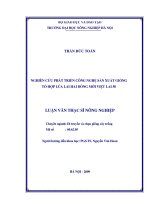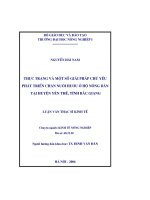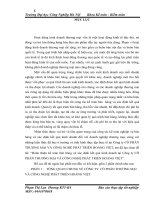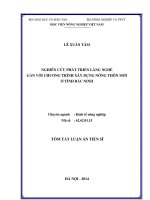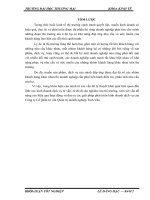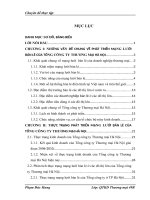Phát triển đội ngũ chuyên viên phòng giáo dục và đào tạo thành phố hồ chí minh tt tiếng anh
Bạn đang xem bản rút gọn của tài liệu. Xem và tải ngay bản đầy đủ của tài liệu tại đây (611.05 KB, 33 trang )
MINISTRY OF EDUCATION AND TRAINING
VINH UNIVERSITY
DƯƠNG VĂN THƯ
STAFF DEVELOPMENT IN DISTRICT DIVISIONS
OF EDUCATION AND TRAINING
IN HO CHI MINH CITY
Major: Educational Administration
Code: 9140114
SUMMARY OF DOCTORAL THESIS IN EDUCATION
NGHỆ AN – 2019
The thesis has been completed at:
Vinh University
Supervisors:
1. Associate.Prof. Dr Nguyễn Thị Hường
2. Associate.Prof. Dr Phạm Minh Hùng
Examiner 1: .............................................
Examiner 2: .............................................
Examiner 3: .............................................
The thesis will be defended at the meeting of the Ministerial-level Thesis
Examination Council at:
Vinh University
At............, date.........
The thesis can be referred to as:
- Vietnam National Library
- Vinh University Library
1
INTRODUCTION
1. The rationale of the study
The staff working at district divisions of education and training play a
very important role in advising the leaders of the divisions, helping the district
People's Committee fulfil the state management function of education at the
local level. Developing the staff of the district divisions of education and
training in terms of quantity, quality assurance, and synchronous structure is
an objective and urgent requirement to improve the quality of education in the
district, meeting the requirements of the fundamental and comprehensive
innovation in education. Developing the staff of the district divisions of
education and training is to develop the human resources of the state
management of education. It can be said that ethical qualities, qualifications
and competencies of the staff of the district divisions of education and
training have a great influence on the quality of education in the districts,
especially in the context of the current education reform. Therefore, there is
an urgent need of the profound and comprehensive study of the position, role
and competence framework of the district divisions of education and training,
then based on the findings, solutions can be suggested to develop the staff to
ensure the sufficient quantity, high quality, and appropriate structure to meet
the requirements of the the current education reform.
Ho Chi Minh City is a big city, an important centre of economy, culture,
education and training, science and technology, a hub for international
exchange and integration, a driving and dynamic force which gains great
attraction to the investors in the southern key economic region. It also has an
important political position in the whole country [3]. Ho Chi Minh City is the
most populous city in Vietnam with 24 districts, 322 wards, communes and
towns; The total number of actual residents of the city is currently more than
2
10 million. Ho Chi Minh City has 24 district divisions of education and
training, which are decentralised, authorised to manage preschool, primary
education, secondary and high school education and some other educational
service units under districts. Totally, there are 1,863 schools, 60,599 teachers,
1,345,574 students and other affiliated units [69]. In addition, the district
divisions of education and training are also responsible for the state
management of education in the area for organisations, agencies, units and
individuals operating in the field of education. Currently in Ho Chi Minh
City, due to the situation of natural population development along with
migration, the scale of schools, teachers and students continues to increase
rapidly every year, so the scope of impact of the education and training
divisions to educational institutions and the development of education in Ho
Chi Minh City district is very large.
However, given the current requirements for education innovation
and the scale of education in the city, the staff of the district divisions of
education and training is still in short supply in terms of quantity and
inadequacy in quality. To date, there has not been complete and
comprehensive research on developing staff in the district divisions of
education and training in Ho Chi Minh City. Therefore, it is necessary to
conduct an empirical study of solutions to develop the staff of the district
divisions of education and training in accordance with Ho Chi Minh City's
actual practice. The solutions aim to develop the staff with requirements such
as enough in quantity, synchronous in structure, high in quality; to promote
the effectiveness of state management on education of the district divisions of
education and training in Ho Chi Minh City in order to meet the requirements
of the fundamental and comprehensive education reform and improve the
quality of education.
Based on the mentioned reasons, the thesis entitled "Staff
development in district divisions of education and training in Ho Chi Minh
3
City" was conducted to contribute to the development of high-standard human
resource for education in Ho Chi Minh City.
2. Aims of the study
Based on a literature review and empirical evidence, the thesis
suggested strategies to develop staff in district divisions of education and
training and contributed to the improvement of the state managerial
effectiveness in education in Ho Chi Minh City
3. Subjects and objects of the study
3.1 Subjects of the study: staff in district divisions of education and
training
3.2 Objects of the study: Staff development in district divisions of
education and training.
4. Hypotheses
If it is proposed and implemented synchronously solutions to develop
staff of district divisions of education and training based on the approach of
human resource development, the position of employment and the current
educational practice of Ho Chi Minh City, it is possible to develop the staff in
terms of quantity and quality, synchronous structure adapted to the
requirements of improving the efficiency of the on education in Ho Chi Minh
City.
5. The focus of the study
5.1. Synthesising a literature review on developing the staff of the district
divisions of education and training
5.2. Surveying and assessing the status of activities of developing the staff of
the district divisions of education and training in Ho Chi Minh City.
5.3. Proposing solutions to develop the staff of the district divisions of
education and training in Ho Chi Minh City.
5.4. Exploring and testing the possibility of the proposed solutions for
developing the staff of the district divisions of education and training in Ho
Chi Minh City.
4
6. The scope of the study
- The thesis only focused on researching the development of the staff were
responsible for professional issues in education (preschool, primary and
secondary education) in Ho Chi Minh City.
- Surveying and assessing the status of activities of developing for developing
the staff of the district divisions of education and training with empirical data
collected in 2016 and 2017, exploring the necessity and feasibility of
solutions for staff development in district divisions of education and training
in Ho Chi Minh City. Testing the proposed solutions in Ho Chi Minh City.
7. Research approaches and methodology
7.1. Research approaches
7.1.1. Human resource management approaches
7.1.2. Job position oriented approaches
7.1.3. Competency-based approaches
7.1.4. System-based approaches
7.1.5. Activity-personality approaches
7.1.6. Pragmatic approaches
7.1.7. Developmental approaches
7.2. Research methods
7.2.1.
Theoretical
research
methods:
Analysing,
synthesising,
systematising and generalising theories and previous research to construct a
literature review of the study
7.2.2. Empirical research methods: Survey, interviews, expert
interviews, case study, and experimental study methods.
7.2.3. Statistics analysis methods
8. Main arguments of the study
8.1. The staff of district divisions of education and training play a very
important role in advising the leaders of the divisions, helping the district
5
People's Committee to perform the function of state management of education
in the districts. Developing the staff of district divisions of education and
training in terms of quantity, quality assurance and uniformity is an objective
and urgent requirement in order to improve the quality of education in the
districts, meet the requirements of the fundamental and comprehensive
education reform Developing the staff of district divisions of education and
training is to develop the human resources of the state management of
education. Therefore, developing the staff of district divisions of education
and training must be based on the theory of human resource development and
at the same time take into account their functions, tasks and professional
characteristics.
8.2. Activities to develop the staff of district divisions of education and
training in Ho Chi Minh City in recent years have achieved certain results.
However, given the requirements of the current fundamental and
comprehensive reform, the results have remained shortcomings and
limitation. Therefore, in order to support the staff in district divisions of
education and training in implementing more effectively the function of
advising and assisting the district People's Committees in state management
of education in the districts, it is necessary to have synchronous, scientific and
feasible solutions consistent with the city's economic, cultural, social and
educational practices.
8.3. The potential solutions of the staff development in district divisions of
education and training in Ho Chi Minh City included the following ones: The
thorough discussion on the need to develop the staff of the education and
training district divisions for managers at all levels; Renovating plans for staff
development; Strengthening training and retraining activities to improve the
state management competencies of the staff and staff-to-be; Reforming the
mechanism of recruitment, use and mobilisation of the staff in district
divisions of education and training; Developing a selection of standards as a
basis for assessing the staff in district divisions of education and training;
6
Completing policies to motivate the staff in district divisions of education and
training.
9. Contributions of the study
- Clarifying and supplementing theories related to the staff development
in district divisions of education and training in order to adapt to the
requirements of the comprehensive reform in education; Clarifying the
functions, responsibilities, professional features, competencies and qualities
of staff in district divisions of education and training.
- Assessing and clarifying the current status of staff and staff
development in district divisions of education and training in Ho Chi Minh
City based on strategies to develop staff in general and develop state human
resource in particular; as well as based on the functions, responsibilities,
professional features, competencies and qualities of staff in district divisions
of education and training.
- Based on the theoretical review and pragmatic evidence, the thesis
suggested 6 strategies which had been confirmed their importance and
feasibility in the interventions including renovating staff development plans,
providing training, improving the recruitment, assigning and mobilising of the
staff within the system; designing the rubrics to assess the staff's performance.
The results of the intervention with Strategy 3 were very high.
10. Structure of the thesis
In addition to Introduction, Conclusion, References and Appendixes,
the thesis comprises three chapters as follows:
Chapter 1: Literature review on staff development in district divisions
of education and training
Chapter 2: The current status of the staff development in district
divisions of education and training in Ho Chi Minh City
7
Chapter 3: Solutions to develop the staff in district divisions of
education and training in Ho Chi Minh City.
CHAPTER 1
LITERATURE REVIEW ON STAFF DEVELOPMENT IN DISTRICT
DIVISIONS OF EDUCATION AND TRAINING
1.1.
Overview of the research problem
1.1.1. Findings in the previous study
- Researchers have affirmed that teachers, officials and staff in education
sector in general, managers and administrators of district divisions of
education and training in particular have special positions and roles to ensure
the effectiveness of state management of education, and quality of education.
They have also affirmed that staff development in district divisions of
education and training is a crucial requirement in the current context.
- In recent years, the Communist Party and the government have built and
implemented many guidelines and policies to develop teachers and officials in
the education sector in general, managers and administrators of district
divisions of education and training in particular. That has created
advantageous conditions for the research and development of the staff of
district divisions of education and training.
1.1.2. Gaps in the research field
- In order to well perform the function of state management on education in
districts, staff development of the district divisions of education and training
is an issue that the researchers have paid their attention and appreciated,
especially in the context of the fundamental and comprehensive education
reform. However, these studies are also general, not systematic and profound.
Particularly, there has not been any specific and independent research on
developing the staff of the district divisions of education and training.
- There has not been any research which clarified the responsibilities and
functions of the staff in the district divisions of education and training; their
8
professional characteristics, qualities and competencies in the context of the
fundamental and comprehensive education reform.
- There has not been any research which focuses on specific activities for staff
development in the district divisions of education and training to ensure the
staff would be sufficient in quantity, synchronous in structure, high in quality,
with specific activities of management subjects to develop this team, there is
no work yet. research.
1.1.3. The focus of the study
- Roles, functions and responsibilities of the staff in the district
divisions of education and training in the context of the fundamental and
comprehensive education reform
- Professional characteristics of the staff in the district divisions of
education and training in the context of the fundamental and comprehensive.
- Qualities and competencies of the staff in the district divisions of
education and training in the context of the fundamental and comprehensive
education reform
- Proposed solutions for staff development in the district divisions of
education and training in order to adapt to the requirements of the context of
the fundamental and comprehensive education reform.
1.2. Staff in district divisions of education and training in the
context of education reform
1.2.1. An administrator and staff in district divisions of education and
training
1.2.1.1. An administrator and an administrator in district divisions of
education and training
An administrator in district divisions of education and training: an
administrative staff who does not hold any managerial or lead positions has a
background related to education and is working in state management system
to support the leaders in managing educational activities in the localities. The
staff in district divisions of education and training have responsibilities to
9
provide consultation and implementation of state management of educational
fields such as: preschool education, primary education, secondary and high
school education; inspection, testing; quality accreditation, building schools
reaching national standards; applying Information Technology in education;
providing general education for all students, organising personnel; doing legal
work; completing school health service; conducting office work, doing
planning, statistics, synthesis of education activities….
1.2.1.2. Staff and staff in district divisions of education and training
Staff in district divisions of education and training: a group of
officials working in district divisions of education and training do not hold
any lead or managerial position; they are collaborating together to provide
consultation and fulfil tasks based on their positions related to state
management of education in districts. The nature of their work is also
managerial.
1.2.2. Roles, functions and responsibilities of the staff in district divisions
of education and training
1.2.3. Professional characteristics of the staff in district divisions of
education and training
Pursuant to the Prime Minister's Decision No. 42/2011 / QD-TTg on
August 5, 2011, related to preserving the regime of preferential allowances
for teachers who were transferred to educational administration, the policies
for those teachers have been clarified. The document also stated clearly that
when the teachers are transferred to district divisions of education and
training, their responsibilities would be related to educational administration.
The nature of the work of the staff in district divisions of education and
training is a complex and specialised form of labour including the task of
advising, proposing and implementing the state management on education in
the districts under the orders the heads and deputy heads of the divisions.
Their activities are related to management, the nature of their work is
10
managerial
(state
management
of
education)
with
the
following
characteristics:
1.2.3.1. The professional work of the staff in district divisions of
education and training is the combination of the scientific and artistic
requirements
1.2.3.2. The professional work of the staff in district divisions of
education and training is the combination of communication and
interpersonal relationship
1.2.3.3. The professional work of the staff in district divisions of
education and training is providing consultation and implementing decisions
of management effectively and timely, appropriately to the current practice of
education in the districts.
1.2.3.4. The professional work of the staff in district divisions of
education and training is value-oriented and aims to build the working
culture for educational institutions and communities.
1.2.3.5. The professional work of the staff in district divisions of
education and training is the combination of the consultation and
implementation of the innovative initiatives in education in the districts.
1.2.3.6. The professional work of the staff in district divisions of
education and training is the connection between the administrators in the
district divisions of education and training and the ones in educational
institutions in the districts.
1.2.4. Requirements of qualities and competencies of the staff in
district divisions of education and training in the context of education
reform.
Qualities, competencies of the staff in district divisions of education
and training includes political qualities, professional ethics, professional
competencies, pedagogical competencies, managerial competencies and social
competencies.
11
1.2.5. Challenges for the staff in district divisions of education and
training in the context of comprehensive education reform
- In the knowledge-based, globalised economy and the industrial revolution
4.0, elite education has been transferred to mass education, knowledge-based
education has been transferred to competency-based one with a range of
opportunities. The staff in district divisions of education and training have to deal
with challenges, especially the requirements of STEM education so that they can
provide good consultation to the leaders and managers in state management of
education in the districts.
- The staff in district divisions of education and training have to be in charge
of connecting the administrators in the district divisions and the administrators in
educational institutions in the districts; of encouraging and promoting human
resources for the local education reform.
- Requirements of comprehensive education reform, the new curriculum
implementation and textbooks after 2019 demanded the staff in district
divisions of education and training to have full perception and understanding
of the new curriculum and textbooks to complete their state administration in
education effectively.
- Requirements of qualities and competencies of the staff in district
divisions of education and training to ensure their functions of state
management of education in the districts in the context of fundamental,
comprehensive education reform and in the periods of industrialisation and
modernisation of the country.
- Requirements of the sustainable development and motivation to
reform education and educational administration for the localities in the
context of the current education reform.
1.3. Staff development in district divisions of education and
training
1.3.1. Development and staff development in district divisions of
education and training
12
1.3.1.1. Development
1.3.1.2. Human resource development
1.3.1.3. Staff development in district divisions of education and training
Developing the staff of district divisions of education and training is
the application of human resource development theory. Developing these staff
is the process of interference from educational management leaders and
managers to educational management subordinates by policies, programmes
and solutions to ensure the quantity, quality and structure of the organisation
and meet the requirements of state management of education in the districts
under the authority of the divisions in the process of the current education
reform. The nature of the staff development is encouraging the staff to
develop themselves in terms of quantity, qualities, and competencies to adapt
to the requirements of state management of education in the districts and
attain educational goals in the new context.
Developing the staff of district divisions of education and training
aims to sufficient in quantity, high in quality and synchronized in structure.
1.3.2. The necessity of staff development in district divisions of
education and training
1.3.2.1. Meeting the requirements of developing the staff to perform
the tasks of state management of education in the period of accelerating
industrialisation and modernisation.
1.3.2.2. Meeting the requirements of improving the effectiveness and
efficiency of state management of education in the localities.
1.3.2.3. Meeting the requirements of the fundamental and
comprehensive education reform
1.3.2.4. Meeting the requirements of directing and managing the
development of national general education curriculum and textbooks in the
direction of developing the qualities and competencies of students and
implementing new books and textbooks of general education after 2019
13
1.3.3. Contents of the staff development in district divisions of
education and training
1.3.3.1. Planning of the staff development in district divisions of
education and training
1.3.3.2. Training to improve the qualifications and competencies for the
staff in district divisions of education and training
1.3.3.3. Recruiting, using and mobilising the staff in district divisions of
education and training
1.3.3.4. Testing and assessing the staff in district divisions of education
and training
1.3.3.5. Improving policies to enhance the working motivation of the
staff in district divisions of education and training
1.4. Stakeholders of the staff development in district divisions of
education and training
1.4.1. Chairmen of the city People' Committee
1.4.2. Directors of the Department of Education and Training
1.4.3. Chairmen of the district People’s Committee
1.4.4. Heads of district divisions of education and training
1.5. Factors of staff development in district divisions of education
and training
1.5.1. Objective factors: The process of globalisation, the knowledgebased economy and the information society; perspectives of the Communist
Party and the government on staff development to perform the functions and
tasks of educational management; the process of changing the management
mechanism from a centralised administrative mechanism to a socialistoridented market mechanism; requirements of the fundamental and
comprehensive education reform and the implementation of new general
education textbooks and curriculum after 2019; policies on decentralisation
of state management of education.
14
1.5.2. Subjective factors: Perceptions, visions and perspectives of senior
leaders and managers; the staff’s needs of proving their competencies; their
family and health status; and other features of the staff in district divisions of
education and training
Conclusions of Chapter 1
1. The staff in district divisions of education and training play crucial
roles in providing consultation and implementation of state management of
education in the districts in the context of the fundamental and comprehensive
education reform. To fulfil these roles, the staff have to meet requirements of
qualities and competencies including political qualities and professional
ethics; professional and pedagogical competencies; managerial and social
competencies.
2. Developing the staff in district divisions of education and training is
a part of human resource development. Therefore, the development of these
staff has to rely on theories of human resource development. This means that
the development has to include developing in quantity, structure, qualities and
competencies so that the staff can adapt to requirements of state management
of education in the districts in the new context.
3. Staff development in district divisions of education and training in
the current context is extremely necessary. Contents of the staff development
comprise of the following issues: Planning for staff development; design and
implementing training programmes for the staff; recruiting, using and
mobilising the staff; testing and assessing the staff; establishing policies for
the staff.
4. Factors influencing staff development in district divisions of
education and training include subjective and objective ones; these factors
create opportunities as well as challenges for staff development. Therefore,
stakeholders of educational administration need to put these factors under
consideration when they develop the staff.
15
CHAPTER 2
THE CURRENT STATUS OF STAFF DEVELOPMENT IN DISTRICT
DIVISIONS OF EDUCATION AND TRAINING
IN HO CHI MINH CITY
2.1. Overview of the survey
2.1.1. Objectives of the survey
2.1.2. The content of the survey
2.1.3. Subjects, place and time of the survey
2.1.4. Instruments of the survey
2.1.5. Procedures of the survey
2.1.6. Data analysis
2.2. Results of the survey
2.2.1. Overview of the economic, social and educational status of Ho
Chi Minh City
2.2.2. The current status of the staff in district divisions of education
and training in Ho Chi Minh City
2.2.2.1. The current status of the quantity and structure of the staff in
district divisions of education and training in Ho Chi Minh City
2.2.2.2. The current status of the quality of the staff in district divisions
of education and training in Ho Chi Minh City
2.2.3. The current status of the staff development in district
divisions of education and training in Ho Chi Minh City
2.2.3.1. The current status of awareness of managers on staff
development in district divisions of education and training
2.2.3.2. The current status of establishing standards of the staff in
district divisions of education and training, planning for staff development in
district divisions of education and training
16
2.2.3.3. The current status of training, self-directed learning to improve
the level and competencies of state management of education for the staff and
the staff-to-be in district divisions of education and training
2.2.3.4. The current status of recruiting, assigning and mobilising of the
staff within the system
2.2.3.5. The current status of the inspection and assessment of the staff
in district divisions of education and training
2.2.3.6. The current status of policies, motivation, building a favourable
working environment for the staff in district divisions of education and
training; organising visits for the staff and providing abroad training in
management for the staff
2.2.4. The current status of factors affecting staff development in district
divisions of education and training
Levels
TT Factors
Highly
influential
The process of
Amount
Influential
Slightly
influential
Not at all
influenti
al
783
244
24
28
72.5
22.6
2.22
2.59
945
100
10
24
87.58
9.27
0.93
2.22
globalisation, the
1
knowledge-based
Percentage
economy and the
(%)
information society
The views of the
Amount
Communist Party and the
2
government on staff
development being in
charge of educational
administrators
Percentage
(%)
17
The process of
Amount
799
210
35
35
74.05
19.46
3.24
3.24
817
163
60
39
75.72
15.11
5.56
3.61
800
240
10
29
74.14
22.24
0.93
2.69
860
189
10
20
79.70
17.52
0.93
1.85
750
237
45
47
69.51
21.96
4.17
4.36
835
200
20
24
77.39
18.54
1.85
2.22
6589
1583
214
246
76.33
18.34
2.48
2.85
transforming the
management mechanism
3
from a centralised
administrative
mechanism to a socialist-
Percentage
(%)
oriented market
mechanism
Requirements of the
Amount
fundamental and
comprehensive education
4
reform and the
implementation of new
general education
Percentage
(%)
textbooks and curriculum
after 2019
Policies on
5
decentralisation of state
management of
education
6
Amount
Percentage
(%)
Perceptions, visions and
Amount
perspectives of senior
Percentage
leaders and managers
(%)
The needs to demonstrate Amount
7
8
competencies of each
Percentage
staff
(%)
Family and health status
Amount
of the staff in district
divisions of education
and training
Percentage
(%)
Amount
Total
Percentage
(%)
18
2.3. General assessment
2.3.1. Advantages
2.3.2. Disadvantages
2.3.3. Causes
Conclusions of Chapter 2
1. In recent years, staff development in district divisions of education
and training in Ho Chi Minh City City has been developing quickly in terms
of their quality and quantity. However, according to requirements of the
current education reform, the staff in district divisions of education and
training in Ho Chi Minh City City had many limitation on the following
aspects: A large number of staff who did not qualify the requirements of
political and moral qualities; the levels and competencies of the staff in state
management of education are still limited, most of them fulfilled the tasks of
state management of education based on their own experience, they had not
been properly trained; lack of competencies in using information technology
and foreign languages; the competencies in advising the management and
guiding of STEM-oriented educational methods at schools were limited; not
having a thorough understanding of application of interdisciplinary teaching,
organising creative hands-on activities for students and assessing students
based on their competencies...
2. The results of survey show that: Activities for staff development in
district divisions of education and training in Ho Chi Minh City at district
level still existed some limitation such as: Managers at different levels,
managers and the staff in district divisions of education and training had not
been yet fully and deeply awared of the position and important roles of the
staff in district divisions of education and training in improving the quality of
education and the effectiveness and efficiency of the state management of
19
education; they had not yet issued standards of the staff in district divisions of
education and training in the current context; The development plans for the
staff in district divisions of education and training was not good; training
activities to improve the capacity of state management of education for staff,
and staff-to-be district divisions of education and traininghave had not been
highly effective; Policies for the staff within the system was still inadequate,
had not yet improved the working motivation of the staff in district divisions
of education and training, had not attracted many managers and teachers with
good experience and professional skills to work at district divisions of
education and training... The results of the survey also showed that the
objective and subjective factors had a significant influence on staff
development in district divisions of education and training.
3. The results of the research status showed the necessity of the
proposed solutions of the staff development in district divisions of education
and training in Ho Chi Minh City to adapt to the requirements of the
education reform.
CHAPTER 3
SOLUTIONS FOR STAFF DEVELOPMENT IN DISTRICT
DIVISIONS OF EDUCATION AND TRAINING IN HO CHI MINH
CITY
3.1. Principles of proposing solutions
3.1.1. Principles to ensure the goals of the solutions
3.1.2. Principles to ensure the comprehensiveness of the solutions
3.1.3. Principles to ensure the practicality of the solutions
3.1.4. Principles to ensure the feasibility of the solutions
20
3.1.5. Principles to ensure the efficiency of the solutions
3.2. Solutions for staff development in district divisions of
education and training.
3.2.1. Organising activities to deliver the necessity of staff
development in district divisions of education and training to managers
at different levels.
3.2.2. Renovating the development plan for staff development in
district divisions of education and training.
3.2.3. Developing the training programmes to improve the capacity
of state management of education for the staff and staff-to-be in district
divisions of education and training.
3.2.4. Renovating the mechanism of recruitment, assigning and
mobilising of the staff within the system.
3.2.5. Design the rubrics for assessing the staff in district divisions
of education and training
3.2.6. Completing policies, enhancing motivation for the staff in
district divisions of education and training
3.3. Links between solutions
3.4. A Survey on the necessity and feasibility of solutions
3.4.1. Purpose of the survey
3.4.2. The content of the survey
3.4.3. Procedures of the survey
3.4.4. Participants
3.4.5. Survey results on the necessity and feasibility of the proposed
solutions
3.4.5.1. The necessity of the proposed solutions:
Table 3.2. Evaluation of the importance of the proposed solutions
21
The level of the necessity of the solution
TT
Solutions
Very
necessary
Organise activities to
Amount
Necessary
Slightly
necessary
Not
necessary
at all
715
255
100
9
66.27
23.63
9.27
0.83
820
210
44
5
76.00
19.46
4.08
0.46
940
110
26
3
87.12
10.19
2.41
0.28
799
220
50
10
74.05
20.39
4.63
0.93
deliver the necessity of
staff development in
1
district divisions of
Percentage
education and training to
(%)
managers at different
levels
Renovating the
Amount
development plan for
2
staff development in
Percentage
district divisions of
(%)
education and training
Develop the training
Amount
programmes to improve
the competency of state
management of
3
education for staff,
Percentage
officers and officials who (%)
are planned to become
staff of district divisions
of education and training
Renovating the
Amount
mechanism of
4
recruitment, assigning
Percentage
and mobilizing of the
(%)
staff within the system
22
Design the rubrics for Amount
5
assessing the staff in
district
divisions
of
education and training
Completing
6
Percentage
(%)
policies, Amount
800
211
65
3
74.14
19.56
6.02
0.28
911
160
8
0
84.43
14.83
0.74
0.00
4985
1166
293
30
77.00
18.01
4.53
0.46
improving motivation for
staff in district divisions
of education and training
Percentage
(%)
Amount
Total
Percentage
(%)
The survey results in Table 3.2 show that respondents had a high
appreciation of the necessity of the proposed solutions. In particular, the
number of responses of “very necessary” and “necessary” in all 06 solutions
accounted for a high proportion (from 89.9% to 99.26%); Especially, the
solution "Completing policies, improving motivation for staff in district
divisions of education and training" made up 99.26% of the respondents who
considered it very necessary and necessary. This affirms the inadequacy and
unsuitability in implementing policies for the staff in district divisions of
education and training currently. Only a very small amount of responses was
“not necessary at all” (less than 1%). The results proved that the proposed
solutions are essential for staff development in district divisions of education
and training in Ho Chi Minh city.
23
3.4.5.2. The feasibility of the proposed solutions
Table 3.3. Evaluate the feasibility of the proposed solutions
The level of the feasibility of the
solutions
TT
Solutions
Very
feasible Feasible
Slightly
feasible
Not
feasible
at all
Organise activities to deliver the
necessity of staff development in
1
district divisions of education and
Amount
213
146
7
66.08
19.74
13.53
0.65
837
200
38
4
77.57
18.54
3.52
0.37
900
149
27
3
83.41
13.81
2.50
0.28
799
218
56
6
74.05
20.2
5.19
0.56
801
201
72
5
74.24
18.63
6.67
0.46
879
155
38
7
81.46
14.37
3.52
0.65
4929
1136
377
32
76.14
17.55
5.82
0.49
training to managers at different
levels
Percentage
(%)
Renovating development plans for
2
713
Amount
staff development in district divisions Percentage
of education and training
(%)
Develop training programmes to
Amount
improve the capacity of state
3
management of education for the
Percentage
staff and staff-to-be in district
(%)
divisions of education and training
Renovating the mechanism of
4
5
6
Amount
recruitment, assigning and mobilising Percentage
of the staff within the system
(%)
Design the rubrics for assessing the
Amount
staff in district divisions of education
Percentage
and training
(%)
Completing policies, generating
Amount
motivation for staff in district
Percentage
divisions of education and training
(%)
Amount
TOTAL
Percentage
(%)


